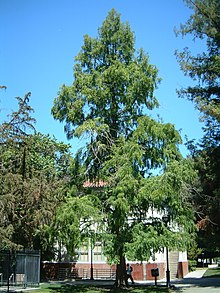| Metasequoia glyptostroboides | |
|---|---|

| |
| Scientific classification | |
| Kingdom: | Plantae |
| Clade: | Tracheophytes |
| Clade: | Gymnospermae |
| Division: | Pinophyta |
| Class: | Pinopsida |
| Order: | Cupressales |
| Family: | Cupressaceae |
| Genus: | Metasequoia |
| Species: | M. glyptostroboides
|
| Binomial name | |
| Metasequoia glyptostroboides | |
Metasequoia glyptostroboides, the dawn redwood, is a fast-growing, endangered deciduous conifer. It is the sole living species of the genus Metasequoia, one of three genera in the subfamily Sequoioideae of the family Cupressaceae. It now survives in the wild only in wet lower slopes and montane river and stream valleys in the border region of Hubei and Hunan provinces and Chongqing municipality in south-central China,[2] notably in Lichuan county in Hubei. Although the shortest of the redwoods, it can grow to 167 ft (51 m) in height.[3][2]

In 1941, the genus Metasequoia was reported by paleobotanist Shigeru Miki as a widely distributed extinct genus based on fossils, before attracting considerable attention a few years later when small populations were found alive in central China. It is a well-known example of a living fossil species. The tree faces considerable risks of extinction in its wild range due to deforestation; however, it has been planted extensively in arboreta worldwide, where it has proved a popular and fast-growing ornamental plant. If the species had not been discovered when it was, it might have become extinct before being investigated.[4]
- ^ Farjon, A. (2013). "Metasequoia glyptostroboides". IUCN Red List of Threatened Species. 2013: e.T32317A2814244. doi:10.2305/IUCN.UK.2013-1.RLTS.T32317A2814244.en. Retrieved 19 November 2021.
- ^ a b Tang, Cindy Q; Yang, Yongchuan; Ohsawa, Masahiko; Momohara, Arata; Hara, Masatoshi; Cheng, Shaolin; Fan, Shenghou (2011). "Population structure of relict Metasequoia glyptostroboides and its habitat fragmentation and degradation in south-central China". Biological Conservation. 144 (1): 279–289. Bibcode:2011BCons.144..279T. doi:10.1016/j.biocon.2010.09.003.
- ^ Dirr, Michael A. (2009). Manual of Woody Landscape Plants. Champaign, Illinois: Stipes Publishing L. L. C. p. 748. ISBN 978-1-58874-868-3.
- ^ Cite error: The named reference
aawas invoked but never defined (see the help page).
